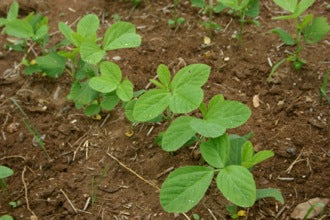Commercial soy is one of most heavily industrialized crops, with most of what's grown in North America genetically modified. The mass produced version of this humble legume couldn't be further removed from the abundance of traditional varieties out there. There are varieties for fresh eating, varieties for soups and baked beans, and varieties for fermenting into miso, tempeh and natto. Lets reclaim the traditional varieties, grow them, and be nourished by them.
- Growing Soybeans in the Maritimes -
Soybeans are very easy to grow, they're tough plants that can tolerate drought and poor soil. They're also well adapted to most of the Maritime provinces, they like warm summers but if you can grow good regular beans you can probably grow soybeans.
They can be treated almost exactly the same way as regular bush beans. I direct sow starting in late May and try to get them all in by the Solstice. Spacing is similar to bush beans, usually 3" or 4" between plants within each row. Choose a sunny spot, ideally one that stays sunny into the autumn for drying and maturing pods. Soybeans are great nitrogen fixers (often used as cover crops), so can thrive in less than perfect soil. They do need good drainage though, they're not fans of soggy roots.


By late August plants will be knee high or taller, and bearing green pods. Pick pods at the edamame stage as soon as they become fully plump. One of my favourite late summer foods is super fresh edamame lightly boiled for just 2-3 minutes in salted water, let the pods cool for a few moments and squeeze the beans right into your mouth. Whole edamame pods freeze well also, but fresh is always best. Some varieties are especially bred for edamame, but any variety can be eaten at any stage.
As autumn progresses, green pods turn yellow and then brown. Usually by the end of September or October plants will have dropped their leaves, but they stay standing with their dry pods. Harvest once the beans are hard and dry, I like pulling up and stripping whole stems with a gloved hand (the dry pods are sharp!). Soybean pods can shatter and release their seeds to the wind on hot days when completely mature, so try to pick them before that.
After harvest, we spread the pods out in a place with good air circulation to fully dry them, and when they're crispy we thresh and winnow them!


- Saving Soybean Seeds -
Soybeans are self pollinators, and crosses between varieties are even less common than regular beans or peas. I've been growing soybeans for about 14 years, and I've only ever noticed one cross. That cross ended up as a new variety, the Gaia Soybean. The beans are of course the seeds, so simply save some of your crop for next season.

